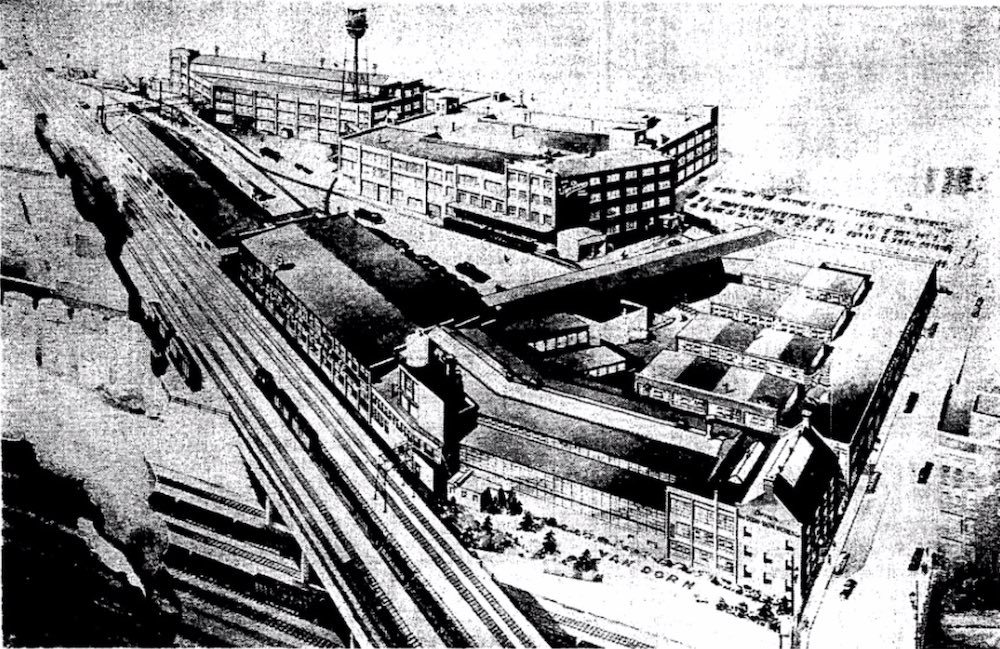Van Dorn Iron Works

The Van Dorn Iron Works Company was one of the leading companies in the iron industry and later plastic molding industry throughout the twentieth century. J. H. Van Dorn started his business in 1872 from the basement of his Akron home where he created a unique style of wrought iron fencing that he displayed in his own front yard which was said to be “such an interesting exhibit that it became town talk.” In 1878, Van Dorn moved his expanding business to Cleveland renaming it the Cleveland Wrought Iron Fence Company.
With the expansion of their product line into ornamental iron objects, Van Dorn renamed the company the Van Dorn Iron Works and became incorporated under The Van Dorn Iron Works Company in 1891. The company produced a variety of different products including ornamental iron products, metal office furniture, structural steel, and automobile parts.
By the 1910s, Van Dorn Iron Works became best known for manufacturing jail cells, which J. H. Van Dorn claimed to be no more than “fences built indoors.” The company became the largest manufacturer of jail cells in the world for several decades in the twentieth century, assembling nearly 28,000 jail cells from 1918 to 1938 that it sold throughout the U.S. and foreign countries. Van Dorn supplied cells for a variety of prisons across the U.S., including the Connecticut State Prison, Nebraska State Prison, West Virginia State Prison, Maryland State Penitentiary, and the Tombs Prison in New York. Van Dorn also assembled jail cells throughout Ohio, including for the Cuyahoga County Jail and the city jails in Cleveland, East Cleveland, and North Royalton.
One of Van Dorn’s unique contributions to the city of Cleveland was the company’s role in constructing the superstructure of the Detroit-Superior Bridge, which was among the world's largest steel and concrete reinforced bridges at the time. Van Dorn built the steel frame of the Williamson Building in 1899 situated on Public Square, which was long considered to be the city’s largest and best building. The Van Dorn Iron Works also constructed the steel crib that was sunk in Lake Erie to supply the city’s fresh water. Other notable contributions made by the Van Dorn Iron Works were contracts to supply iron work to the Cleveland Arcade, the central police station, and the new city hall.
Van Dorn Iron Works was contracted by companies throughout the entire country for their iron products. In 1905, Van Dorn was contracted by the United States government to manufacture 8,000 mailboxes, which offered the company approximately $25,000 in profit. Van Dorn supplied metallic furniture to the Library of Congress and the Post Office Department in Washington D.C.
Van Dorn became an important wartime production company to supply the United States military. During World War I, the Van Dorn Iron Works Company produced Renault six-ton tanks and was only one of three companies in Ohio to produce tanks. Van Dorn also produced a variety of marine furniture for the navy including cots, desks, lockers, and mess tables all of which had to be specially enameled and lacquered. Van Dorn also produced armor plating for military vehicles and aircraft during both World Wars. The Van Dorn Iron Works Company was rated one hundred percent for their wartime production during the First World War, while they received a pennant for outstanding performance in wartime production during World War II.
Following the end of World War II, Van Dorn began diversifying their manufacturing production into the container and plastics fields with the purchase of the Davies Can Company and the Colonial Plastics Mfg. Co. The company also expanded by creating a plastic molding division as early as 1946, which would dominate the company's future success. Throughout the 1950s, Van Dorn grew to become one of the nations leaders in the plastics and container industries. The 1960s was a prosperous decade for Van Dorn as it continued to expand its product line. Van Dorn’s new direction towards producing containers and plastic injection molds led the company to change its name in 1964 to simply the Van Dorn Company.
During the 1970s, Van Dorn participated in the Woodland East Community Organization, or WECO, one of Cleveland’s neighborhood revival programs that intended to revitalize the neighborhood. The Van Dorn Company led the efforts of WECO as Van Dorn’s industrial planning coordinator was the WECO project director. By 1980, the Van Dorn Company was the largest neighborhood employer out of the 26 members of WECO.
During the 1980’s, the Van Dorn Company began to consolidate their subsidiaries due to pressure from Cleveland’s deindustrialization. By 1985, the Van Dorn Company had 19 plants throughout the world following their consolidation and reorganization efforts. The Van Dorn Company closed its East 79th plant in 1991 after being in Cleveland for over one hundred years. The effects of deindustrialization ultimately struck the Van Dorn Company in 1993 when the company was sold to the Crown Cork and Seal Company.
Van Dorn’s survival in Cleveland for over one hundred years contributed substantially to the overall growth of the city. Van Dorn prospered throughout Cleveland’s industrial revolution and did not suffer from the effects of deindustrialization until the late 1980s. The Van Dorn Company led a variety of different industries including the wrought iron fence, jail cell, plastic injection molding, and container industries throughout the twentieth century. Van Dorn’s long existence was due to their successful ability to expand their lines of production into different industries. The Van Dorn Company saw the potential in a variety of different products and maintained a diverse line of production.
Images










